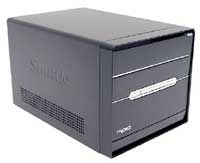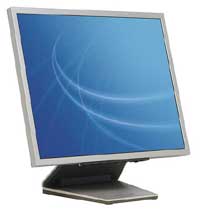Mid-Range SFF Gaming System
One area that we didn't address yet is the potential to go with a small form factor (SFF) system. This especially makes sense for those who attend LAN parties, not to mention the college students that lack space for a large system in their dorm rooms. Many people think that SFF systems are really expensive, but that's not necessarily true. All told, the cost of going with a SFF setup is about $50 more than going with a standard desktop system. There are drawbacks, but first, let's list our SFF configuration, again using an Athlon 64.
| Mid-Range SFF AMD Athlon 64 System |
| Hardware |
Recommended Component |
Price |
| Processor |
AMD Athlon 64 3500+ 512K 2.2 GHz (939) 90nm |
285 |
| Memory |
Mushkin Dual Pack 2x512 PC3200 2.5-3-3 |
159 |
| Video Card |
Albatron GeFORCE 6800 GT 256MB GDDR3 |
374 |
| Hard Drive |
Seagate 160GB SATA 7200RPM 8MB Model ST3160023AS |
93 |
| Optical Drive |
NEC DVD+/-RW Drive Model 3500A |
72 |
| SFF Case |
Shuttle XPC SN95G5 (AMD socket 939) |
299 |
| Display |
Samsung 172X 17 LCD |
429 |
| Speakers |
Logitech Z-640 5.1 |
52 |
| Keyboard |
Logitech Internet Keyboard |
17 |
| Mouse |
Microsoft IntelliMouse Optical |
24 |
| Bottom Line |
|
1804 |

Click to enlarge. |
The total price of our SFF configuration ends up being almost $300 more than the Mid-Range system, but there are reasons for this. We have included a 17" LCD with our SFF recommendation, which is the lion's share of the price increase. After all, what's the point of getting a space-saving, portable case if you're going to pair it with a bulky CRT? That adds an extra $200 to the price, so if you disagree and feel that CRTs and SFFs can peacefully coexist, you can put together a Mid-Range SFF system for $1600. As with the high-end setup, we strongly recommend that anyone looking for a quality LCD get a model that had a DVI-D interface. Unfortunately, one knock against the Samsung 172X is that it is an 18-bit display, which uses dithering/interpolation to "reproduce" 24-bit color. This doesn't matter too much in games, and the 12 ms response time convinces us to go with it anyway, but we're not entirely happy with the options in the 17" LCD segment. Besides the display, remember that a SFF case includes the motherboard and a custom heatsink for the CPU in addition to the case and power supply. So, the $300 cost of the Shuttle XPC takes the place of about $225 of desktop hardware - $250 if you want an aftermarket HSF for your system.

Click to enlarge. |
The one thing that you do sacrifice with a SFF is expansion options. Where most desktop cases can support three or four 5.25" drives, two external 3.5" bays, and three or more internal 3.5" hard drives, the Shuttle XPC that we have used is limited to one 5.25" drive and one 3.5" drive externally, along with one 3.5" internal mount for your hard drive. It is also limited to one AGP slot and one PCI slot, but with all of the included features, the lack of PCI slots is not likely to be an issue. RAM expansion options have been cut back to two DIMM sockets, so even with 1 GB DIMMs, you would max out at 2 GB of RAM. None of these issues are deal-breakers, however, and when paired with a 6800 or X800 graphics card, you have a lot of performance packed into a small, quiet chassis.
We have only included a SFF recommendation for a socket 939 Athlon system, but you could do the same with any other platform. Nearly every motherboard manufacturer has at least one SFF system available, and usually they have several. If you don't upgrade components frequently, SFF cases can be a convenient replacement of the standard "boring" home or office computer.












70 Comments
View All Comments
spartacvs - Wednesday, January 5, 2005 - link
I decided to wait and I'll most probably go for nforce4. One thing I reallly like about your guide is the fact that there is many budgets. Most of the guides provides 3 systems (budget, price/performance and power) but more systems is really helpfull.Careless Joe - Tuesday, January 4, 2005 - link
RE: the "Cheap" psu in the budget case. Its a re-badged fortron. Very reliable.JarredWalton - Saturday, December 4, 2004 - link
Just FYI, I recently upgraded from the integrated audio on my MSI K8N Neo Platinum to an Audigy 2 ZS. My benchmarks in Half-Life 2 (using a measley 9800 Pro) went up a whopping 1 FPS. It might matter more with a faster GPU, but for my setup the sound card didn't matter much. It did, however, eliminate some static/noise from the audio. I couldn't hear it on the speakers, but on headphones it was very noticeable.Was it worth $75? That depends on how much disposable income you have and how annoying any extra static is. Since I often use headphones on my PC at night (no need to wake the wife and neighbors), it was annoying enough for me that I went and spent the money. For most people - particularly those using moderate to cheap speakers - you probably wouldn't notice.
SDA - Saturday, December 4, 2004 - link
Jarred, very true.. I've seen people defend PowerStream purchases after being told that they're the same as Tagans (which I don't do, by the way; I hate to even implicitly insult something that someone else owns) by saying that OCZ is a good name and is better-recognized, as if that really has anything to do with PSU performance. If you ask me, I don't think that sort of thing should really be factored into recommendations.. if someone wants to pay more for a brand name (when it has been demonstrated that there's no functional advantage), they're probably in the minority. (If someone wants to pay more for the PowerStream's looks, they need 20ccs of taste, stat. .. kidding, PowerStream owners ;)Oh, and spartacvs, just remember that integrated audio (non-SoundStorm integrated audio, anyway) will eat more CPU than a dedicated sound card will. It's not much of a big deal with today's overpowered PCs, if you ask me, and you still get plenty of bang for your buck (infinite bang for your buck, actually, since integrated audio is free).
spartacvs - Friday, December 3, 2004 - link
JarredWalton, yes, I think I understand your argument: AGPat the end of his life and PCIe is comming in.I had bad information about integrated audio. Integrated audio is not fantastic but I'm sure it'll be a majhor improvment over my old sb live!value 4.1... And, as I said, it's a way to save a few dollars. Something I, unfortunately, have to be very cautious these days :(
Thank you very much for your wise comments.
JarredWalton - Friday, December 3, 2004 - link
SDA - I understand that the internals are the same. For some people, however, the outside (and the brand) will matter. It doesn't bother me much, but convincing others of this is more difficult to do. I always prefer the weight test for PSUs (assuming you're at a store where you can pick up the PSU). All things being apparently equal, always go with the heavier PSU. :)Spartacvs - *all* motherboards include integrated audio these days. What Nforce4 doesn't include is the SoundStorm audio that was in Nforce1 and Nforce2 (certain models). NVIDIA is supposed to be working on a high-definition audio solution, but when that will actually arrive is a little difficult to say. The audio that will be on Nforce4 is the same as what is on most Nforce3 boards these days, so don't worry too much about that. If audio is really important to you, pick up a Creative Audigy 2 ZS (for games) or the M-Audio Revolution 7.1 (for more serious audio work).
SDA - Friday, December 3, 2004 - link
That depends on your definition of close, Jarred ;) The only real differences between them are cosmetic (shell, sticker, brand). The components, layout, and design are nearly identical.If you're having trouble with this concept, here's a parallel for you: Alienware's older notebooks (before they switched to Uniwill) and equivalent Sager notebooks (with a comparable configuration, obviously). Same platform, same layouts, same chassis, same components (possible that they used different brands of memory or something, but that's about it), same party assembling them; the differences are almost entirely cosmetic, and the ones that aren't don't apply to functionality.
Hopefully this is all a little clearer now, the world of computer hardware is really far too convoluted for its own good..
spartacvs - Thursday, December 2, 2004 - link
Ok, thanks for you answer. The place I want to buy have most of the memory brands. It's just muskin, they have only a few models.As for the MB. What I don't like about nforce4 is the lack of integrated audio. It increase the price tag a little bit more and I'm tight on money :(
JarredWalton - Thursday, December 2, 2004 - link
SDA - Just pointing out that they're not identical. Close, perhaps, and which you like more is probably more a matter of preference, but they certainly aren't identical.Spartcvs - Corsair, GEIL, Kingston, OCZ, and quite a few others are decent RAM. For value RAM, Kingston and Corsair are probably the most widely spread, but I don't really know what other countries are like in terms of availability. The difference between the motherboards is more difficult to quantify. I really like Abit boards, but I'm not as keen on the VIA chipset - NVIDIA just seems more stable in my experience. Either one is still a fine motherboard, and there are several other socket 939 NForce3 250 boards available. Now, though, waiting for NForce4 non-SLI might be a good idea - get one of those for ~$130 and get a 6600GT PCIe card.
spartacvs - Thursday, December 2, 2004 - link
Hey guys, I have a few questions.Fisrt, I do not overclock my system and will most probaly go with the Antec 2650 case because it's smaller and still a good case. Will also take the 120 GB HD because 160 is overkill for me (hey I hardly fullfill my actual 40 GB).
I hesitate between the abit board and the msi one. What do I lose going for the abit rather than the msi? The Abit is a via chipset, right?
Where I want to buy they don't have much of the mushkin memory. Can you recommand another brand (and model please because there is so many type of memory modules, it's easy to be lost).
Thanks